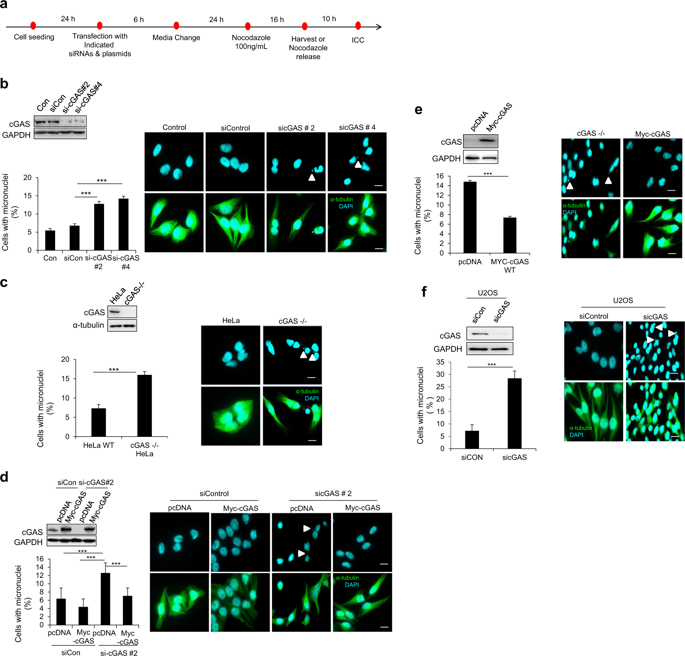当前位置:
X-MOL 学术
›
Exp. Mol. Med.
›
论文详情
Our official English website, www.x-mol.net, welcomes your
feedback! (Note: you will need to create a separate account there.)
The cGAS/STING/TBK1/IRF3 innate immunity pathway maintains chromosomal stability through regulation of p21 levels.
Experimental & Molecular Medicine ( IF 9.5 ) Pub Date : 2020-04-13 , DOI: 10.1038/s12276-020-0416-y
Abdul Basit 1, 2, 3 , Min-Guk Cho 1, 3, 4 , Eui-Yun Kim 1, 2, 3 , Dohyeong Kwon 5, 6 , Suk-Jo Kang 5 , Jae-Ho Lee 1, 2, 3
Experimental & Molecular Medicine ( IF 9.5 ) Pub Date : 2020-04-13 , DOI: 10.1038/s12276-020-0416-y
Abdul Basit 1, 2, 3 , Min-Guk Cho 1, 3, 4 , Eui-Yun Kim 1, 2, 3 , Dohyeong Kwon 5, 6 , Suk-Jo Kang 5 , Jae-Ho Lee 1, 2, 3
Affiliation

|
Chromosomal instability (CIN) in cancer cells has been reported to activate the cGAS-STING innate immunity pathway via micronuclei formation, thus affecting tumor immunity and tumor progression. However, adverse effects of the cGAS/STING pathway as they relate to CIN have not yet been investigated. We addressed this issue using knockdown and add-back approaches to analyze each component of the cGAS/STING/TBK1/IRF3 pathway, and we monitored the extent of CIN by measuring micronuclei formation after release from nocodazole-induced mitotic arrest. Interestingly, knockdown of cGAS (cyclic GMP-AMP synthase) along with induction of mitotic arrest in HeLa and U2OS cancer cells clearly resulted in increased micronuclei formation and chromosome missegregation. Knockdown of STING (stimulator of interferon genes), TBK1 (TANK-binding kinase-1), or IRF3 (interferon regulatory factor-3) also resulted in increased micronuclei formation. Moreover, transfection with cGAMP, the product of cGAS enzymatic activity, as well as add-back of cGAS WT (but not catalytic-dead mutant cGAS), or WT or constitutively active STING (but not an inactive STING mutant) rescued the micronuclei phenotype, demonstrating that all components of the cGAS/STING/TBK1/IRF3 pathway play a role in preventing CIN. Moreover, p21 levels were decreased in cGAS-, STING-, TBK1-, and IRF3-knockdown cells, which was accompanied by the precocious G2/M transition of cells and the enhanced micronuclei phenotype. Overexpression of p21 or inhibition of CDK1 in cGAS-depleted cells reduced micronuclei formation and abrogated the precocious G2/M transition, indicating that the decrease in p21 and the subsequent precocious G2/M transition is the main mechanism underlying the induction of CIN through disruption of cGAS/STING signaling.
中文翻译:

cGAS/STING/TBK1/IRF3 先天免疫途径通过调节 p21 水平维持染色体稳定性。
据报道,癌细胞中的染色体不稳定性(CIN)可通过微核形成激活 cGAS-STING 先天免疫途径,从而影响肿瘤免疫和肿瘤进展。然而,cGAS/STING 通路与 CIN 相关的副作用尚未得到研究。我们使用敲低和添加回方法来分析 cGAS/STING/TBK1/IRF3 途径的每个组成部分来解决这个问题,并且我们通过测量诺考达唑诱导的有丝分裂停滞释放后的微核形成来监测 CIN 的程度。有趣的是,在 HeLa 和 U2OS 癌细胞中,cGAS(环 GMP-AMP 合酶)的敲除以及有丝分裂停滞的诱导明显导致微核形成和染色体错误分离的增加。STING(干扰素基因刺激剂)、TBK1(TANK 结合激酶 1)或 IRF3(干扰素调节因子 3)的敲低也会导致微核形成增加。此外,用cGAMP(cGAS酶活性的产物)转染,以及cGAS WT(但不是催化死亡突变体cGAS)或WT或组成型活性STING(但不是无活性STING突变体)的回加可挽救微核表型,证明 cGAS/STING/TBK1/IRF3 通路的所有成分都在预防 CIN 中发挥作用。此外,cGAS、STING、TBK1和IRF3敲低细胞中p21水平降低,伴随着细胞G2/M转变提前和微核表型增强。在 cGAS 耗尽的细胞中过表达 p21 或抑制 CDK1 可减少微核形成并消除早熟的 G2/M 转变,表明 p21 的减少和随后的早熟 G2/M 转变是通过破坏cGAS/STING 信号传导。
更新日期:2020-04-24
中文翻译:

cGAS/STING/TBK1/IRF3 先天免疫途径通过调节 p21 水平维持染色体稳定性。
据报道,癌细胞中的染色体不稳定性(CIN)可通过微核形成激活 cGAS-STING 先天免疫途径,从而影响肿瘤免疫和肿瘤进展。然而,cGAS/STING 通路与 CIN 相关的副作用尚未得到研究。我们使用敲低和添加回方法来分析 cGAS/STING/TBK1/IRF3 途径的每个组成部分来解决这个问题,并且我们通过测量诺考达唑诱导的有丝分裂停滞释放后的微核形成来监测 CIN 的程度。有趣的是,在 HeLa 和 U2OS 癌细胞中,cGAS(环 GMP-AMP 合酶)的敲除以及有丝分裂停滞的诱导明显导致微核形成和染色体错误分离的增加。STING(干扰素基因刺激剂)、TBK1(TANK 结合激酶 1)或 IRF3(干扰素调节因子 3)的敲低也会导致微核形成增加。此外,用cGAMP(cGAS酶活性的产物)转染,以及cGAS WT(但不是催化死亡突变体cGAS)或WT或组成型活性STING(但不是无活性STING突变体)的回加可挽救微核表型,证明 cGAS/STING/TBK1/IRF3 通路的所有成分都在预防 CIN 中发挥作用。此外,cGAS、STING、TBK1和IRF3敲低细胞中p21水平降低,伴随着细胞G2/M转变提前和微核表型增强。在 cGAS 耗尽的细胞中过表达 p21 或抑制 CDK1 可减少微核形成并消除早熟的 G2/M 转变,表明 p21 的减少和随后的早熟 G2/M 转变是通过破坏cGAS/STING 信号传导。

































 京公网安备 11010802027423号
京公网安备 11010802027423号